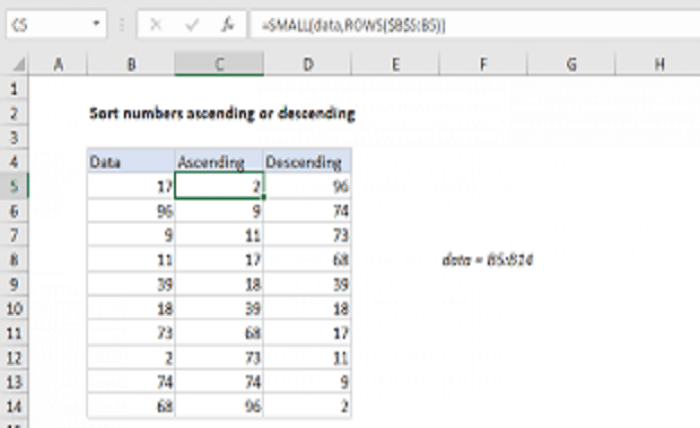Sorting Numbers in Ascending Order: A Comprehensive Guide

Introduction
Sorting numbers in ascending order is the process of arranging a list of numbers from the smallest to the largest. This simple yet powerful operation is a cornerstone of data management and computational tasks. Whether you are dealing with small data sets or large databases, knowing how to sort numbers in ascending order can greatly enhance your ability to analyze and interpret data.
Importance of Sorting Numbers in Ascending Order
The importance of sorting numbers in ascending order cannot be overstated. It is essential for:
- Data organization: Sorted data is easier to read and understand.
- Efficient searching: Binary search algorithms require sorted data.
- Data analysis: Many statistical methods and visualizations require sorted data.
- Algorithm optimization: Some algorithms perform better with sorted input.
Basic Methods to Sort Numbers in Ascending Order
There are several basic methods to sort numbers in ascending order, each with its own advantages and disadvantages. The most common methods include:
- Bubble Sort
- Insertion Sort
- Selection Sort
- Merge Sort
- Quick Sort These methods vary in complexity and efficiency, making it important to choose the right one for your specific needs.
Bubble Sort: A Simple Technique
Bubble sort is one of the simplest methods to sort numbers in ascending order. It repeatedly steps through the list, compares adjacent elements, and swaps them if they are in the wrong order. This process continues until the list is sorted. While easy to implement, bubble sort is not very efficient for large data sets due to its O(n^2) time complexity.
Insertion Sort: An Efficient Approach
Insertion sort is another simple method to sort numbers in ascending order. It builds the final sorted array one element at a time by repeatedly picking the next element and inserting it into its correct position. Insertion sort is more efficient than bubble sort for small data sets, with an average time complexity of O(n^2), but it performs well with nearly sorted data.
Merge Sort: Handling Large Data Sets
Merge sort is a more advanced method to sort numbers in ascending order. It uses a divide-and-conquer approach, breaking the list into smaller sublists, sorting them, and then merging them back together. Merge sort is highly efficient with a time complexity of O(n log n), making it suitable for large data sets. It is also stable, meaning it maintains the relative order of equal elements.
Quick Sort: Fast and Effective
Quick sort is another efficient method to sort numbers in ascending order. It works by selecting a ‘pivot’ element and partitioning the array into two sub-arrays, one with elements less than the pivot and one with elements greater than the pivot. The process is repeated recursively. Quick sort has an average time complexity of O(n log n) and is generally faster than merge sort, though it is not stable.
Comparison of Sorting Algorithms
When choosing a method to sort numbers in ascending order, it is important to consider the characteristics of each algorithm:
- Bubble Sort: Simple, but inefficient for large data sets.
- Insertion Sort: Efficient for small or nearly sorted data sets.
- Merge Sort: Stable and efficient for large data sets.
- Quick Sort: Generally the fastest, but not stable. Each algorithm has its own strengths and weaknesses, making it important to select the right one based on the specific requirements of your task.
Practical Applications of Sorting Numbers in Ascending Order
Sorting numbers in ascending order has numerous practical applications across various fields:
- Database Management: Efficient querying and indexing.
- Computer Graphics: Sorting coordinates for rendering.
- Financial Analysis: Organizing and analyzing stock prices.
- Machine Learning: Preprocessing data for algorithms.
- Scientific Research: Analyzing experimental data.
Conclusion
Sorting numbers in ascending order is a fundamental skill with wide-ranging applications. By understanding and mastering various sorting algorithms, you can significantly enhance your ability to organize, analyze, and interpret data. Whether you are a programmer, data analyst, or researcher, knowing how to efficiently sort numbers in ascending order is an invaluable asset.
FAQs
1. What is the best algorithm to sort numbers in ascending order? The best algorithm depends on the context. Quick sort is generally the fastest, but merge sort is better for large data sets that require stability.
2. Can I sort numbers in ascending order using Excel? Yes, Excel has built-in functions to sort numbers in ascending order easily through its data sorting features.
3. Why is sorting numbers in ascending order important in programming? Sorting is crucial for optimizing search algorithms, organizing data, and improving the efficiency of other algorithms.
4. Is bubble sort ever useful for sorting numbers in ascending order? Bubble sort is useful for educational purposes and small data sets, but it is not efficient for large data sets due to its O(n^2) time complexity.
5. How does sorting numbers in ascending order help in data analysis? Sorted data is easier to analyze and visualize, enabling more effective statistical analysis and data interpretation.



